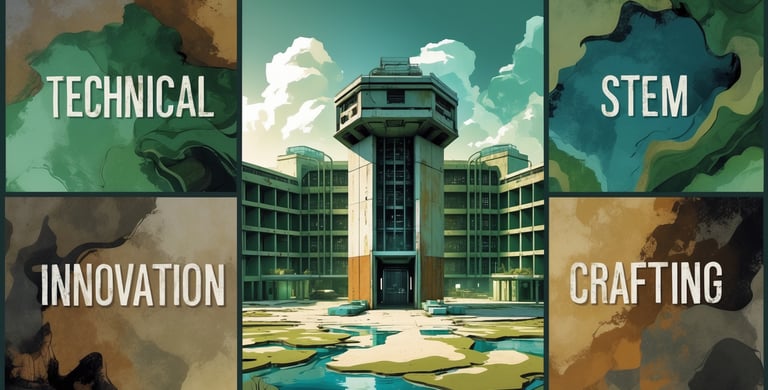Household Diagnostics and Practical Engineering
Shaping Sovereignty Through Vigilance and Applied Science
4FORTITUDET - TECHNICAL SKILLS, CREATIVE ARTS, STEM
Household Diagnostics and Practical Engineering
Shaping Sovereignty Through Vigilance and Applied Science
"The greater the obstacle, the more glory in overcoming it." — Molière
When infrastructure crumbles and specialists vanish, every home becomes a fortress whose strength depends entirely on its caretaker. True sovereignty demands that a man transform himself into both vigilant guardian and skilled engineer, capable of diagnosing problems before they manifest and engineering solutions when they inevitably arise. This is not mere skill—it is survival embodied.
Marcus Aurelius instructs: "You have power over your mind—not outside events." Similarly, Sengcan, the Zen patriarch, reminds: "The great way is not difficult if you simply do not pick and choose." Both teachings underscore one vital principle: diagnostic vigilance and practical engineering are not optional luxuries—they are existential obligations.
Core Knowledge Foundation
Effective diagnostics and practical engineering pivot upon mastering key systems critical to household sovereignty:
Home Infrastructure: Electrical, plumbing, structural integrity.
Vehicles: Engines, transmissions, electrical components.
Survival Gear: Generators, solar panels, water purification systems, communications.
Weapons and Defense: Firearms, bows, melee weapons, protective gear.
Three foundational practices solidify this mastery:
Observation
Sensory awareness to identify subtle anomalies.
Preventative Maintenance
Routine checks, lubrications, and adjustments to preempt failures.
Functional Redundancy
Backup solutions ensuring operational continuity.
Tactical Implementation Snapshot
Perform a structured weekly walkthrough to inspect critical systems.
Maintain a "Fault Ledger" noting subtle irregularities and resolutions.
Establish redundancy through manual backup systems for electricity, water, heating.
Assemble a diagnostic toolkit: multimeter, compression tester, mechanical stethoscope.
Regularly practice basic vehicle emergency repairs (tire changes, belt replacements).
Advanced Insights
The paradox of diagnostic vigilance lies in the technician’s curse—the deeper one's knowledge, the clearer a system's fragility becomes. Yet, this heightened awareness does not paralyze but fortifies the sovereign man. Seeing weakness allows preemptive strengthening, turning vulnerability into resilience. Acknowledging systemic fragility fosters preparedness rather than despair.
"The man who diagnoses early reigns quietly."
Tactical Implementation Snapshot
Regularly document vulnerabilities observed and actions taken to mitigate them.
Conduct reflective evaluations to anticipate systemic failures.
Teach observational techniques to household members for collective vigilance.
Critical Perspectives
Critics of household diagnostics and practical engineering assert efficiency through specialization, advocating reliance on professional services. Yet, historical cycles repeatedly reveal that specialists vanish or become inaccessible precisely when most needed. Self-sufficiency is therefore not inefficiency; it is insurance against societal breakdown.
Decision Point: Will you depend on the fragile promise of specialist availability, or will you build the resilience that independence guarantees?
Tactical Implementation Snapshot
Audit personal reliance: list services regularly outsourced and strategize their in-house replication.
Pursue informal or formal certifications in basic repair and maintenance skills.
Integrate routine diagnostic practices into household culture.
Applied Science and Practical Engineering
Engineering transcends diplomas and formal credentials; it is fundamentally the disciplined application of science to solve real-world problems. Historical engineers were not bureaucrats but builders of bridges, fortifications, and survival systems. Reclaiming this heritage means engaging directly with principles of physics, thermodynamics, and material science.
Core engineering principles:
Observation: Identify clearly "What is occurring?"
Hypothesis Formation: Understand "Why is this happening?"
Testing and Verification: Determine "How can I confirm my assumptions?"
Iterative Adaptation: Continually refine based on feedback and experience.
Applied engineering ensures dominion over one's immediate environment, creating tangible power from intellectual rigor and manual skill.
Tactical Implementation Snapshot
Construct a mechanical lifting device from scrap materials.
Install a small solar power charging station.
Fortify a critical access point using leverage and structural engineering principles.
Build a multi-stage passive water purification system.
Assemble a basic communications receiver using rudimentary materials.
Paradox of Expertise and Experimentation
Excessive formal education often restricts innovation through fear of failure or deviation from established norms. The self-taught engineer, however, often operates free from these constraints, empowered to experiment boldly and learn pragmatically from direct experience. This paradox reveals a deeper truth: practical competence is often stifled by credentialism but thrives in the hands of courageous, disciplined amateurs.
Tactical Implementation Snapshot
Regularly engage in experimental projects to reinforce practical problem-solving.
Document all outcomes rigorously to cultivate a personal engineering knowledge base.
Foster a culture of controlled experimentation within your community or household.
Final Charge & Implementation
"An ounce of prevention is worth a pound of cure." — Benjamin Franklin
Immediate Actions:
Establish a Master Systems Ledger: Map major household systems and schedule regular maintenance tasks. This is your tactical playbook for preventing catastrophic failures.
Initiate a Silent Walk: Conduct a detailed, sensory-based inspection of your entire domain, noting anomalies and creating immediate plans for corrective action.
Existential Reflection:
If tomorrow your household became your sole refuge, are you equipped with the knowledge and practical skill to defend, maintain, and sustain it indefinitely?
Living Archive Element
Create a "Diagnostics and Engineering Codex":
Systematic documentation of weekly inspections.
Detailed logs of repairs and modifications.
Emergency diagnostic procedures and engineering blueprints.
This Codex is more than a manual—it is your legacy, providing future generations with the blueprints for self-reliance and survival.
"The man who can shape systems with his mind and hands becomes the architect of every dawn."


